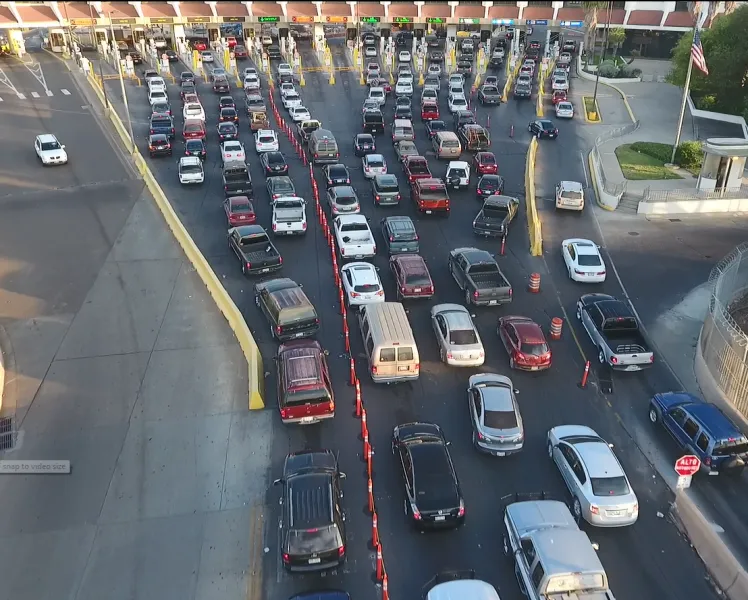LAREDO, Texas – As the onslaught of heavy traffic has reached its highest point this Holy Week, U.S. Customs and Border Protection officers at the Laredo Port of Entry have thrust into high gear a variety of effective measures to facilitate a smooth, orderly traffic flow, including a designated lane, electronic tourist permits, expanded processing hours and satellite tourist permit processing booths in multiple locations.
“For CBP, Holy Week is one of the busiest travel periods of the year and our deployment of these multiple facilitation measures has helped enormously to keep wait times down to manageable levels while retaining our ability to maintain our border security mission,” said Port Director Gregory Alvarez, Laredo Port of Entry. “Travelers were also encouraged to present WHTI (Western Hemisphere Travel Initiative) compliant documents during inspection, and ensure they are not in possession of inadmissible or prohibited goods. These efforts, along with business transformational initiatives to expedite permit and commercial bus processing implemented by CBP have resulted in an overall wait time reduction of approximately one-third compared to previous Semana Santa travel seasons,” Alvarez said.

primary inspection booths at Lincoln-Juarez
Bridge is one of many measures implemented
to facilitate Holy Week traffic at Laredo Port
of Entry
Port Director Alvarez continued, “CBP would like to thank the traveling public for their partnership and encourages continued use of trusted traveler and designated local traveler lanes and WHTI-compliant documents through the remainder of the Semana Santa travel season. CBP followed through with these implemented programs which resulted in facilitated travel throughout this holiday season.”
“Our frontline officers at Laredo Port of Entry have really hit the ball out of the park in terms of innovation by deploying these off-site tourist permit processing stations,” said Director, Field Operations David P. Higgerson, Laredo Field Office. “That coupled with a careful and constant analysis of traffic volumes and deploying organic resources to meet the workload has proven effective in managing these peak traffic flows while carrying out the CBP mission.”
The Laredo Port of Entry strongly encourages travelers to apply for their tourist permits online.Travelers will now receive a provisional I-94 after submitting their application and payment online. To finalize the I-94 process, travelers must present themselves at a port of entry within seven days of their application to be interviewed by a CBP officer, submit biometric fingerscans and a photo is taken. Laredo Field Office ports of entry will extend front of the line privileges to travelers who submit their I-94 applications electronically and present their provisional I-94 permit receipt.
CBP, in collaboration with the newly constructed Outlet Shoppes at Laredo, have implemented a Mobile Processing Center for issuance of I-94 tourist permits. The Mobile Enrollment Center is available from 10 a.m. to 7 p.m., through April 15, 2017 and is located in the first floor at the west end of the Outlet Shoppes at Laredo, 1600 Water St.
The satellite I-94 tourist permit processing station at Texas Travel Information Center (TTC) at mile marker 18 on Interstate 35 will be available through April 15, 2017. The TTC will continue to operate on an as-needed basis during the expected high peak travel period of Semana Santa. CBP will monitor I-94 tourist permit processing lanes and will refer individuals to the TTC for further processing.
In close coordination with the Government of Mexico and the City of Laredo, the designated lane, which is designed for local cross border traffic that does not require tourist permits or other benefits is available through April 15, 2017.
The designated lane, which runs the full length of the Lincoln-Juarez international bridge and fans out to three primary inspection booths, has delineators installed to indicate their location to local commuters and to ensure that daily local traffic is being processed in a timely manner. CBP encourages daily border crossers to utilize these assigned lanes which are located on the three Westernmost lanes of the Lincoln-Juarez Bridge.
CBP also encourages travelers to obtain and utilize radio-frequency identification technology (RFID)-equipped travel documents such as U.S. passport cards and the newer versions (i.e. since 2011) of the border crossing card and resident alien card so that they can utilize Ready Lanes. Processing in Ready Lanes is 20 percent faster than normal lanes and provide a time savings of up to 20 seconds per vehicle. Those who have renewed their entry documents within the last 24 months already have radiofrequency identification enabled documents (RFID) and may not know it. CBP encourages travelers to obtain RFID entry documents to use Ready Lanes and enroll in trusted traveler programs.
Members of the traveling public can monitor Border Wait Times or also obtain the BWT app on their smartphone via Apple App Store and Google Play so that they can observe the wait times and make an informed decision on which bridge to use. These wait times are updated on an hourly basis.
CBP reminds the public that they may utilize the Colombia-Solidarity Bridge as an alternate route to avoid heavy traffic. CBP had enacted expanded hours at Colombia-Solidarity Bridge during the first weekend of Holy Week and will continue to monitor traffic.
Also to avoid any potential delays or fines due to travelers bringing prohibited/restricted agricultural items, CBP encourages travelers to declare all agricultural items to a CBP officer upon arrival and before making their journey to consult the Know Before You Go webpage.

